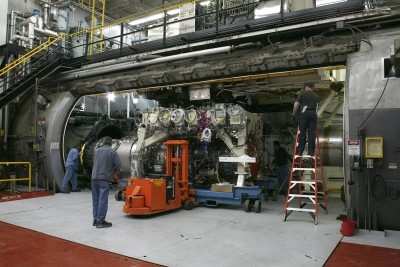Runs Full Propulsion System For STOVL Operations
The team developing the alternate engine for the F-35 Joint
Strike Fighter says it has surpassed a major test goal for 2010,
launching tests on the sixth new F136 engine this year. The F136
test team has also run a full propulsion system for the first time
with the common hardware for STOVL operation.

F136 Engine File Photo
Testing began in late November on Engine #009, an endurance
engine, and Engine #006, which was re-configured into STOVL mode
following earlier tests. The F136 team has compiled more than 850
test hours in 2010, with a goal of reaching 1000 by year’s
end. Four F136 engines, at three locations, are testing
concurrently for the first time.
The GE/Rolls-Royce decision in 2005 to resize the F136 engine
with a larger core and higher-flow fan is proving fortuitous as
test engines are being run to extreme flight conditions. The
resized core and fan provide a low-risk solution for the F136
System Development and Demonstration program, and the engine will
enter production with cooler running temperatures. That will
translate into a long-term maintenance cost advantage as high as 25
percent over the competing JSF engine. The engine testing has
verified the temperature advantage as predicted.

File Photo
Full flight envelope testing necessary to validate the F136
performance model, to demonstrate meeting specification thrust
requirements, and to integrate the engine control software with the
Joint Strike Fighter F-35 aircraft is being conducted on an F136
development engine (#005) at the U.S. Air Force Arnold Engineering
Development Center (AEDC) in Tullahoma, Tennessee. Engine #005 has
accumulated more than 330 hours of testing and is expected to
continue running at AEDC for several more weeks.
“We are eager to complete measurements of F136 installed
thrust and operating temperatures throughout the flight envelope.
The engine has already demonstrated the capability of 15+ percent
thrust margin against specification at sea level, static
condition,” said Al DiLibero, President of the GE Rolls-Royce
Fighter Engine Team. “The AEDC testing has confirmed for us
that the F136 is performing at, or better than, all of our test
expectations.”
Since the JSF specification includes the propulsion system
losses associated with installing the engine into the aircraft, the
F136 engine was tested as if it was installed in the aircraft for a
true comparison of capability available to the warfighter. On an
uninstalled basis, the thrust margin at the sea level, static
condition is significantly greater (typically about 20 percent
above the “installed thrust” measurement).
“These positive test results give the Fighter Engine Team
great confidence moving toward first flight next year,” said
Mark Rhodes, Senior Vice President of the GE Rolls-Royce Fighter
Engine Team. “The significant temperature margins will mean
big savings for the customer in future.”

File Photo
F136 test engine #007 continues to run at GE Aviation’s
Evendale, Ohio, test facility where valuable data on the higher
airflow fan is being mapped with simulated inlet distortion. Engine
#007 has more than 265 hours of test time.
Production is underway on Flight Test Engine #041, the first
F136 to flight test on the F-35 Lightning II aircraft. Final
assembly occurs early next year, with acceptance testing slated in
mid-2011. Engine #041 is scheduled to flight test on AF-1 test
aircraft late next year.
 Unfortunate... ANN/SportPlane Resource Guide Adds To Cautionary Advisories
Unfortunate... ANN/SportPlane Resource Guide Adds To Cautionary Advisories ANN FAQ: Turn On Post Notifications
ANN FAQ: Turn On Post Notifications ANN's Daily Aero-Term (04.29.24): Visual Approach Slope Indicator (VASI)
ANN's Daily Aero-Term (04.29.24): Visual Approach Slope Indicator (VASI) ANN's Daily Aero-Term (04.28.24): Airport Marking Aids
ANN's Daily Aero-Term (04.28.24): Airport Marking Aids ANN's Daily Aero-Linx (04.28.24)
ANN's Daily Aero-Linx (04.28.24)





